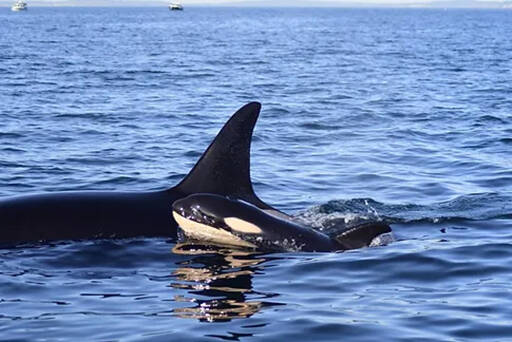FRIDAY HARBOR — It’s a boy.
A newborn orca calf spotted by researchers Mark and Maya Sears the day after Christmas has been confirmed by Dave Ellifrit of the Center for Whale Research (CWR) to be a male.
Ellifrit was able to determine the sex of the orca calf through viewing a photograph by Maya Sears.
Based on a CWR count in July, the Southern Resident population was 75, so the new arrival to J Pod brings the population of Southern Resident orcas to 76.
The July census found 25 orcas in J Pod, 16 in K Pod and 34 in L Pod. Another count was expected to be done Sunday.
The calf was not with the pod in recent encounters with CWR encounters, or when the Sears saw the whales on the Dec. 23, so the calf is considered to be just days old when it was spotted, researchers said on the CWR website at https://www.whaleresearch.com.
When it was spotted, the calf was swimming most often near adult female J40, who had not yet had a calf, researchers said.
“J40 seems to be the most likely mother, but we’ll try to confirm this in subsequent encounters,” CWR said.
Newsweek reported that the calf is a rare “peachy” colored orca.
“The Southern Residents are a highly endangered population, so monitoring the population is crucial,” a spokesperson for the Center for Whale Research told Newsweek. “In a population as small as the Southern Residents, each new birth is a bit of a boost, if the calves can survive.”
Researchers told Newsweek that female orcas have an average interbirth interval of about six years, but this can vary.
“The population can go years without successful births, but this year’s been a relatively good one; this new calf is the third birth confirmed this year,” Newsweek was told.
The three pods of the Southern Resident orcas form a large extended family, or clan. They are fish eaters as opposed to the Pacific clan of orcas that eat mammals.
Captures for marine parks decimated the three pods in the 1960s and early 1970s. According to the CWR website, at least 13 orcas were killed while 45 were delivered to parks worldwide. Seventy-one Southern Residents survived in 1974. Following the death of Tokitae/Sk’aliChelt-tenaut in Miami in August 2023, none now live in captivity.
In the mid-1990s, the population recovered to 98 animals, the CWR said, but that number declined to 78 by 2001.
Earlier in 2023, two calves were born to L Pod, L126, a male, and L127, a female.
________
Executive Editor Leah Leach can be reached at 360-417-3530 or at leah.leach@peninsuladailynews.com.

